Analysis of NHS Leadership, Talent Management, and Training
VerifiedAdded on 2022/05/10
|11
|2753
|118
Report
AI Summary
This report examines the change management strategies within the National Health Service (NHS) of the United Kingdom, focusing on leadership, talent management, and training and development. The NHS faces challenges including employee shortages, attributed to factors such as maternity leave, recruitment inefficiencies, and work pressure. The report highlights the NHS's initiatives, including increased training programs, leadership development, and talent management strategies aimed at improving employee retention and service quality. Key areas discussed include the shift towards collaborative leadership, the importance of training and development for employee performance, and the implementation of strategies to retain skilled healthcare professionals. Recommendations are provided to address issues such as employee dissatisfaction, discrepancies in pay, and the need for effective rewarding policies. The report emphasizes the need for fair performance evaluations, transparent compensation, and the engagement of employees to improve overall organizational performance and address the demands of the healthcare industry.
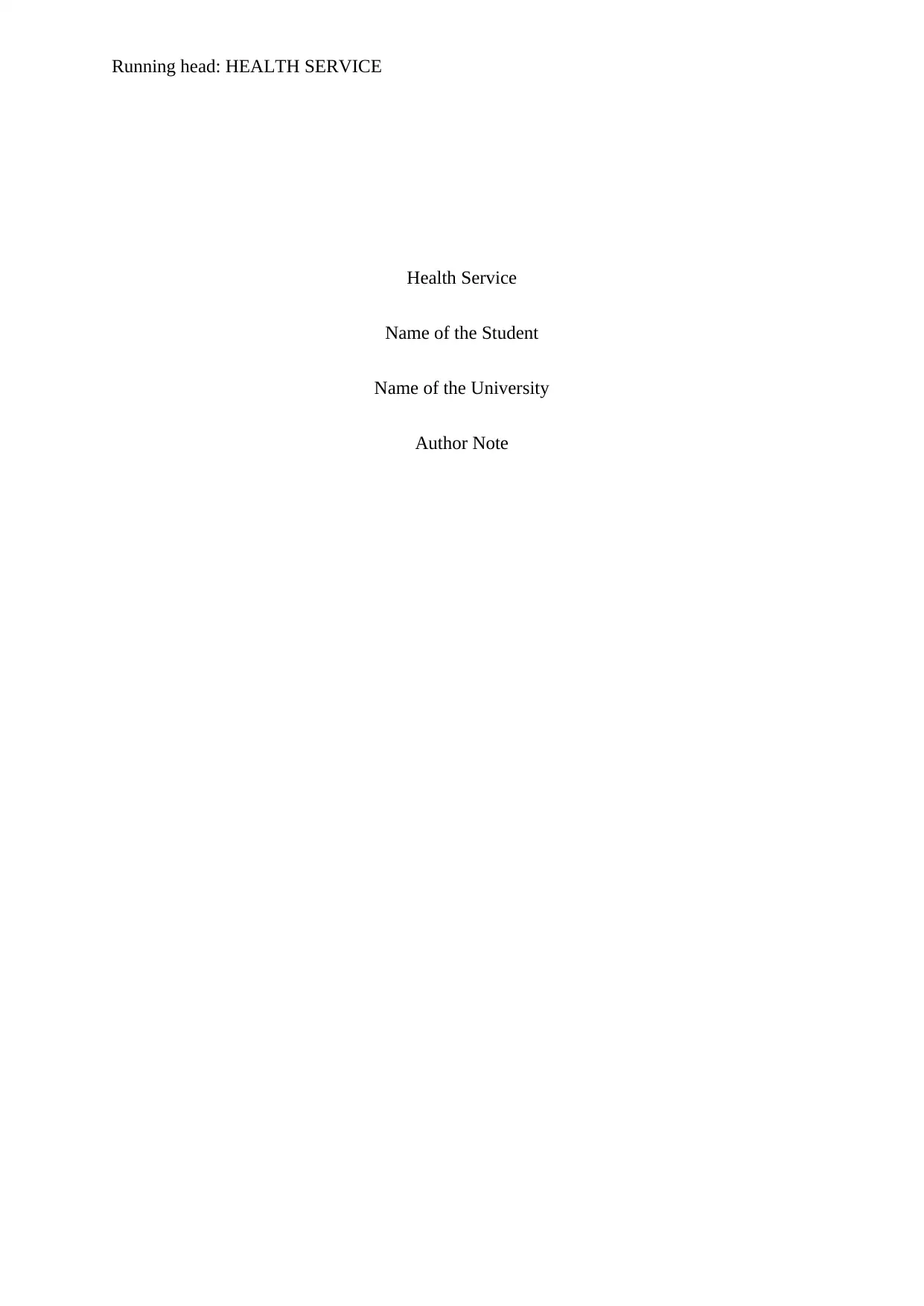
Running head: HEALTH SERVICE
Health Service
Name of the Student
Name of the University
Author Note
Health Service
Name of the Student
Name of the University
Author Note
Paraphrase This Document
Need a fresh take? Get an instant paraphrase of this document with our AI Paraphraser
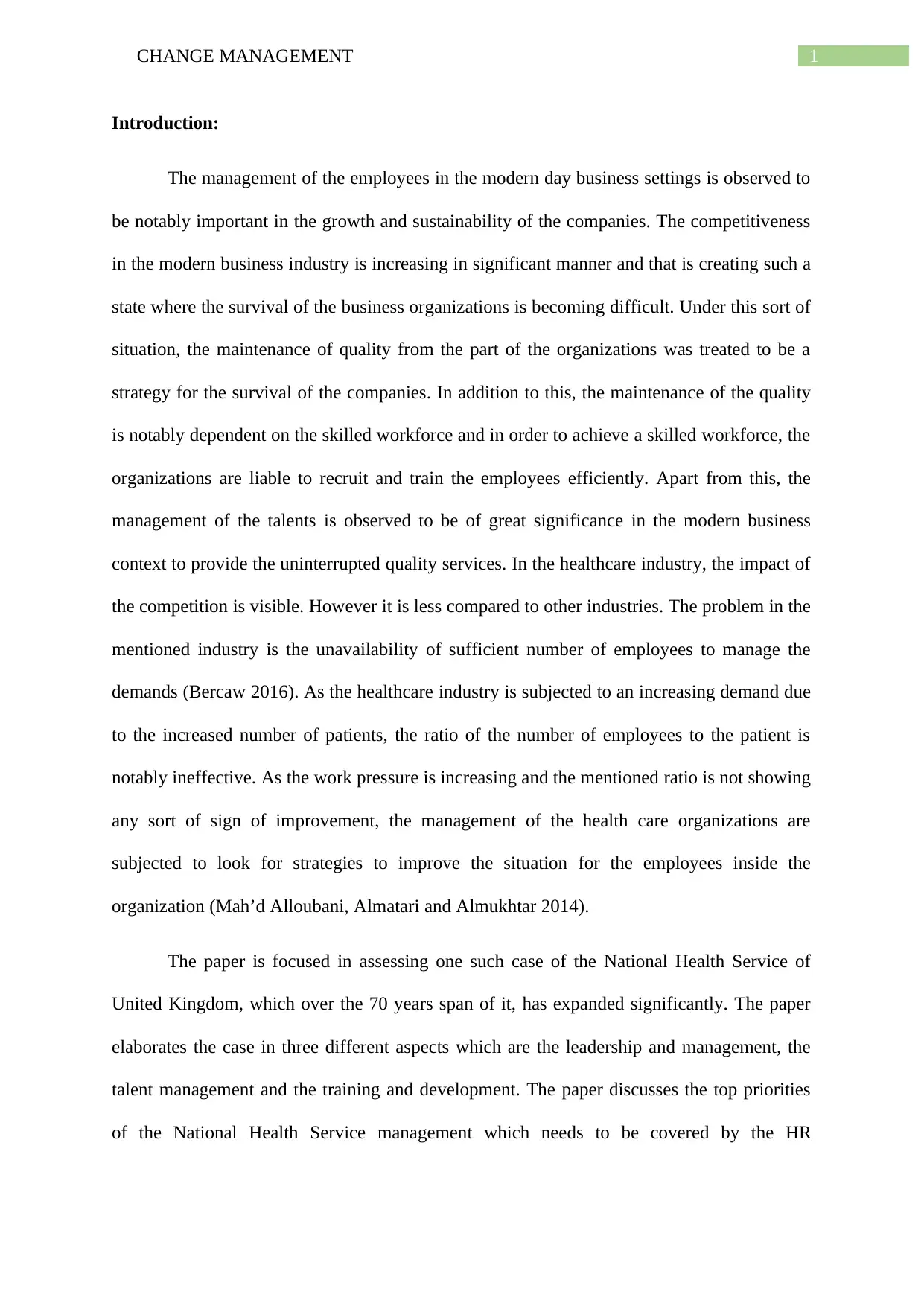
1CHANGE MANAGEMENT
Introduction:
The management of the employees in the modern day business settings is observed to
be notably important in the growth and sustainability of the companies. The competitiveness
in the modern business industry is increasing in significant manner and that is creating such a
state where the survival of the business organizations is becoming difficult. Under this sort of
situation, the maintenance of quality from the part of the organizations was treated to be a
strategy for the survival of the companies. In addition to this, the maintenance of the quality
is notably dependent on the skilled workforce and in order to achieve a skilled workforce, the
organizations are liable to recruit and train the employees efficiently. Apart from this, the
management of the talents is observed to be of great significance in the modern business
context to provide the uninterrupted quality services. In the healthcare industry, the impact of
the competition is visible. However it is less compared to other industries. The problem in the
mentioned industry is the unavailability of sufficient number of employees to manage the
demands (Bercaw 2016). As the healthcare industry is subjected to an increasing demand due
to the increased number of patients, the ratio of the number of employees to the patient is
notably ineffective. As the work pressure is increasing and the mentioned ratio is not showing
any sort of sign of improvement, the management of the health care organizations are
subjected to look for strategies to improve the situation for the employees inside the
organization (Mah’d Alloubani, Almatari and Almukhtar 2014).
The paper is focused in assessing one such case of the National Health Service of
United Kingdom, which over the 70 years span of it, has expanded significantly. The paper
elaborates the case in three different aspects which are the leadership and management, the
talent management and the training and development. The paper discusses the top priorities
of the National Health Service management which needs to be covered by the HR
Introduction:
The management of the employees in the modern day business settings is observed to
be notably important in the growth and sustainability of the companies. The competitiveness
in the modern business industry is increasing in significant manner and that is creating such a
state where the survival of the business organizations is becoming difficult. Under this sort of
situation, the maintenance of quality from the part of the organizations was treated to be a
strategy for the survival of the companies. In addition to this, the maintenance of the quality
is notably dependent on the skilled workforce and in order to achieve a skilled workforce, the
organizations are liable to recruit and train the employees efficiently. Apart from this, the
management of the talents is observed to be of great significance in the modern business
context to provide the uninterrupted quality services. In the healthcare industry, the impact of
the competition is visible. However it is less compared to other industries. The problem in the
mentioned industry is the unavailability of sufficient number of employees to manage the
demands (Bercaw 2016). As the healthcare industry is subjected to an increasing demand due
to the increased number of patients, the ratio of the number of employees to the patient is
notably ineffective. As the work pressure is increasing and the mentioned ratio is not showing
any sort of sign of improvement, the management of the health care organizations are
subjected to look for strategies to improve the situation for the employees inside the
organization (Mah’d Alloubani, Almatari and Almukhtar 2014).
The paper is focused in assessing one such case of the National Health Service of
United Kingdom, which over the 70 years span of it, has expanded significantly. The paper
elaborates the case in three different aspects which are the leadership and management, the
talent management and the training and development. The paper discusses the top priorities
of the National Health Service management which needs to be covered by the HR
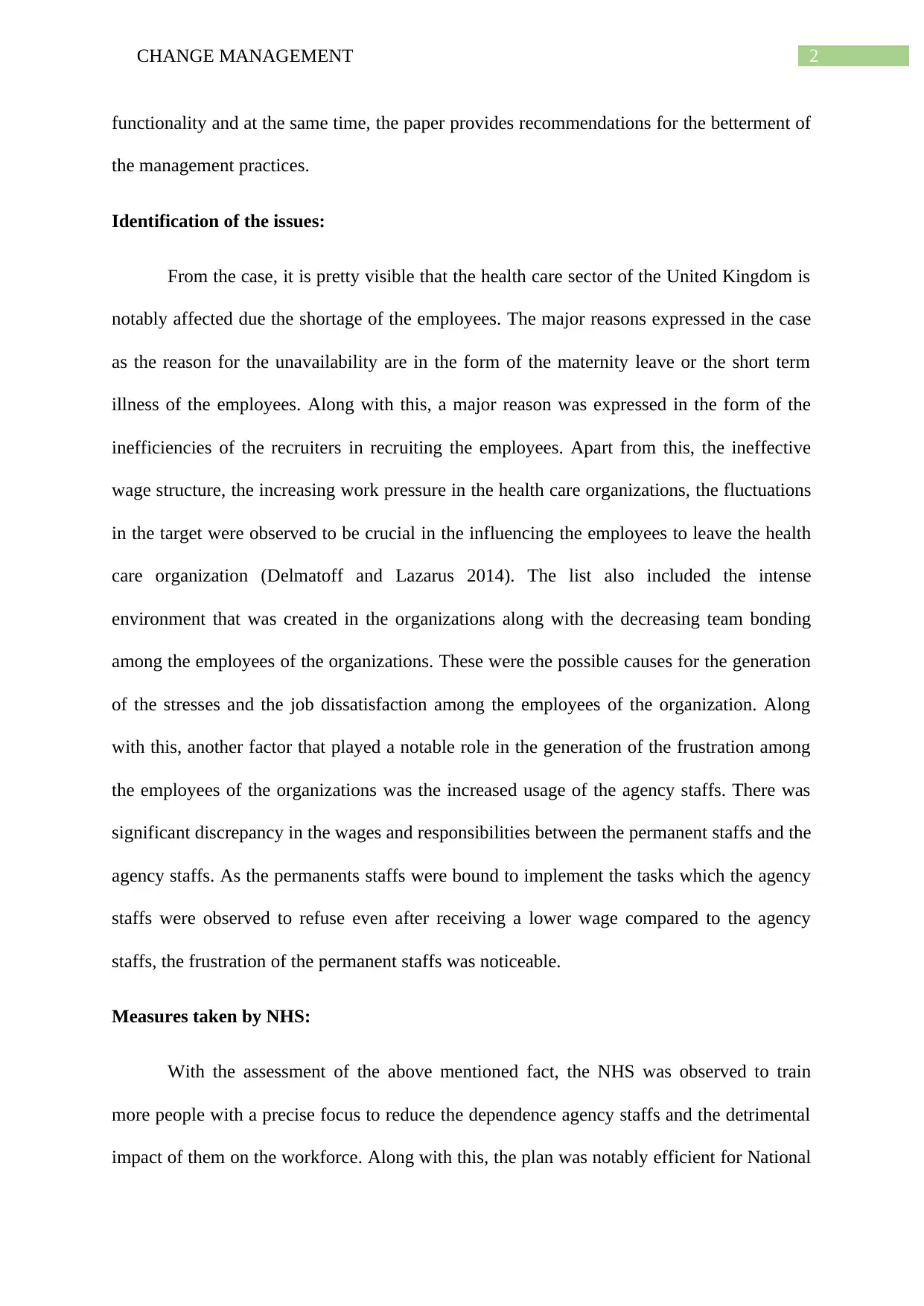
2CHANGE MANAGEMENT
functionality and at the same time, the paper provides recommendations for the betterment of
the management practices.
Identification of the issues:
From the case, it is pretty visible that the health care sector of the United Kingdom is
notably affected due the shortage of the employees. The major reasons expressed in the case
as the reason for the unavailability are in the form of the maternity leave or the short term
illness of the employees. Along with this, a major reason was expressed in the form of the
inefficiencies of the recruiters in recruiting the employees. Apart from this, the ineffective
wage structure, the increasing work pressure in the health care organizations, the fluctuations
in the target were observed to be crucial in the influencing the employees to leave the health
care organization (Delmatoff and Lazarus 2014). The list also included the intense
environment that was created in the organizations along with the decreasing team bonding
among the employees of the organizations. These were the possible causes for the generation
of the stresses and the job dissatisfaction among the employees of the organization. Along
with this, another factor that played a notable role in the generation of the frustration among
the employees of the organizations was the increased usage of the agency staffs. There was
significant discrepancy in the wages and responsibilities between the permanent staffs and the
agency staffs. As the permanents staffs were bound to implement the tasks which the agency
staffs were observed to refuse even after receiving a lower wage compared to the agency
staffs, the frustration of the permanent staffs was noticeable.
Measures taken by NHS:
With the assessment of the above mentioned fact, the NHS was observed to train
more people with a precise focus to reduce the dependence agency staffs and the detrimental
impact of them on the workforce. Along with this, the plan was notably efficient for National
functionality and at the same time, the paper provides recommendations for the betterment of
the management practices.
Identification of the issues:
From the case, it is pretty visible that the health care sector of the United Kingdom is
notably affected due the shortage of the employees. The major reasons expressed in the case
as the reason for the unavailability are in the form of the maternity leave or the short term
illness of the employees. Along with this, a major reason was expressed in the form of the
inefficiencies of the recruiters in recruiting the employees. Apart from this, the ineffective
wage structure, the increasing work pressure in the health care organizations, the fluctuations
in the target were observed to be crucial in the influencing the employees to leave the health
care organization (Delmatoff and Lazarus 2014). The list also included the intense
environment that was created in the organizations along with the decreasing team bonding
among the employees of the organizations. These were the possible causes for the generation
of the stresses and the job dissatisfaction among the employees of the organization. Along
with this, another factor that played a notable role in the generation of the frustration among
the employees of the organizations was the increased usage of the agency staffs. There was
significant discrepancy in the wages and responsibilities between the permanent staffs and the
agency staffs. As the permanents staffs were bound to implement the tasks which the agency
staffs were observed to refuse even after receiving a lower wage compared to the agency
staffs, the frustration of the permanent staffs was noticeable.
Measures taken by NHS:
With the assessment of the above mentioned fact, the NHS was observed to train
more people with a precise focus to reduce the dependence agency staffs and the detrimental
impact of them on the workforce. Along with this, the plan was notably efficient for National
⊘ This is a preview!⊘
Do you want full access?
Subscribe today to unlock all pages.

Trusted by 1+ million students worldwide
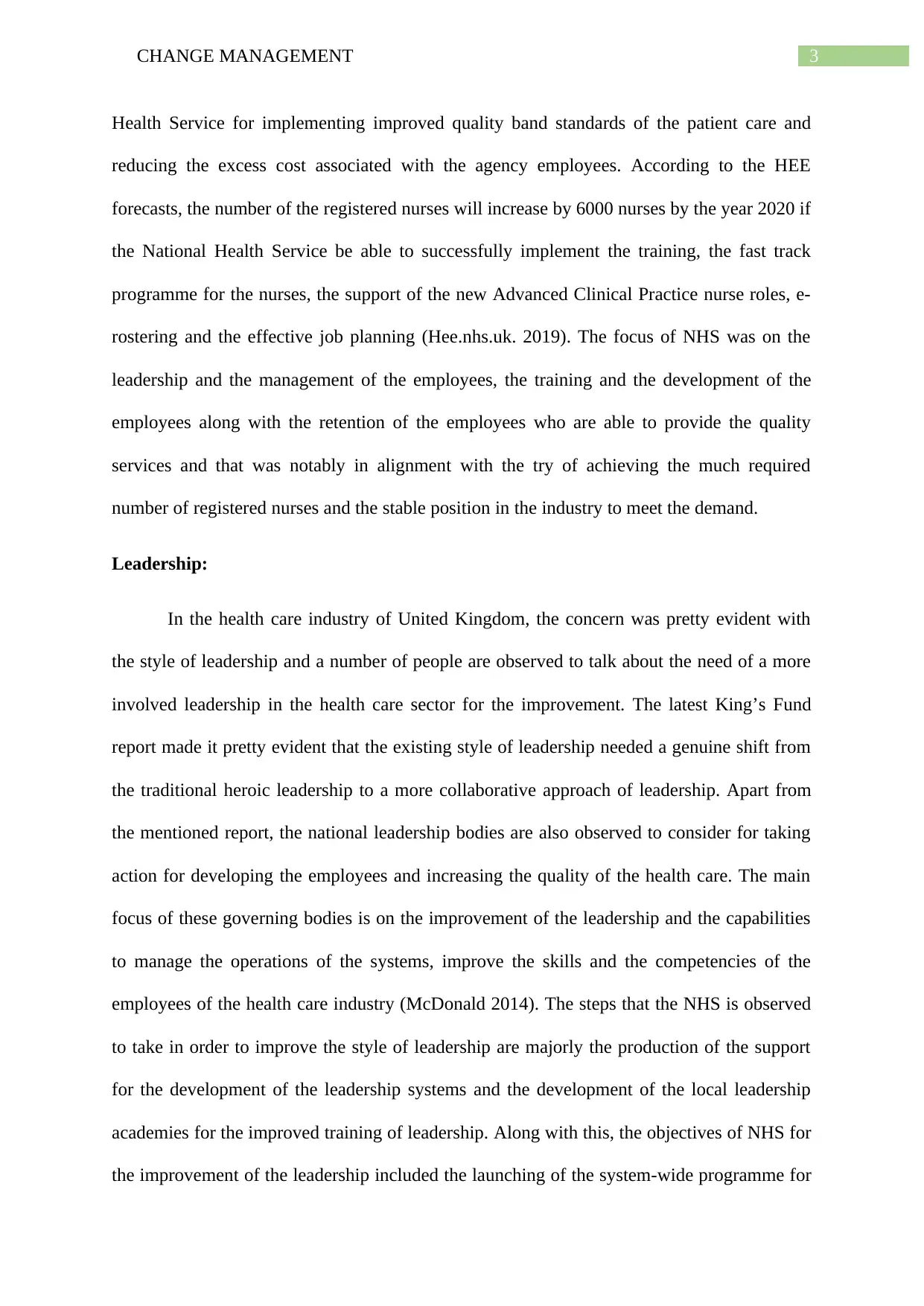
3CHANGE MANAGEMENT
Health Service for implementing improved quality band standards of the patient care and
reducing the excess cost associated with the agency employees. According to the HEE
forecasts, the number of the registered nurses will increase by 6000 nurses by the year 2020 if
the National Health Service be able to successfully implement the training, the fast track
programme for the nurses, the support of the new Advanced Clinical Practice nurse roles, e-
rostering and the effective job planning (Hee.nhs.uk. 2019). The focus of NHS was on the
leadership and the management of the employees, the training and the development of the
employees along with the retention of the employees who are able to provide the quality
services and that was notably in alignment with the try of achieving the much required
number of registered nurses and the stable position in the industry to meet the demand.
Leadership:
In the health care industry of United Kingdom, the concern was pretty evident with
the style of leadership and a number of people are observed to talk about the need of a more
involved leadership in the health care sector for the improvement. The latest King’s Fund
report made it pretty evident that the existing style of leadership needed a genuine shift from
the traditional heroic leadership to a more collaborative approach of leadership. Apart from
the mentioned report, the national leadership bodies are also observed to consider for taking
action for developing the employees and increasing the quality of the health care. The main
focus of these governing bodies is on the improvement of the leadership and the capabilities
to manage the operations of the systems, improve the skills and the competencies of the
employees of the health care industry (McDonald 2014). The steps that the NHS is observed
to take in order to improve the style of leadership are majorly the production of the support
for the development of the leadership systems and the development of the local leadership
academies for the improved training of leadership. Along with this, the objectives of NHS for
the improvement of the leadership included the launching of the system-wide programme for
Health Service for implementing improved quality band standards of the patient care and
reducing the excess cost associated with the agency employees. According to the HEE
forecasts, the number of the registered nurses will increase by 6000 nurses by the year 2020 if
the National Health Service be able to successfully implement the training, the fast track
programme for the nurses, the support of the new Advanced Clinical Practice nurse roles, e-
rostering and the effective job planning (Hee.nhs.uk. 2019). The focus of NHS was on the
leadership and the management of the employees, the training and the development of the
employees along with the retention of the employees who are able to provide the quality
services and that was notably in alignment with the try of achieving the much required
number of registered nurses and the stable position in the industry to meet the demand.
Leadership:
In the health care industry of United Kingdom, the concern was pretty evident with
the style of leadership and a number of people are observed to talk about the need of a more
involved leadership in the health care sector for the improvement. The latest King’s Fund
report made it pretty evident that the existing style of leadership needed a genuine shift from
the traditional heroic leadership to a more collaborative approach of leadership. Apart from
the mentioned report, the national leadership bodies are also observed to consider for taking
action for developing the employees and increasing the quality of the health care. The main
focus of these governing bodies is on the improvement of the leadership and the capabilities
to manage the operations of the systems, improve the skills and the competencies of the
employees of the health care industry (McDonald 2014). The steps that the NHS is observed
to take in order to improve the style of leadership are majorly the production of the support
for the development of the leadership systems and the development of the local leadership
academies for the improved training of leadership. Along with this, the objectives of NHS for
the improvement of the leadership included the launching of the system-wide programme for
Paraphrase This Document
Need a fresh take? Get an instant paraphrase of this document with our AI Paraphraser
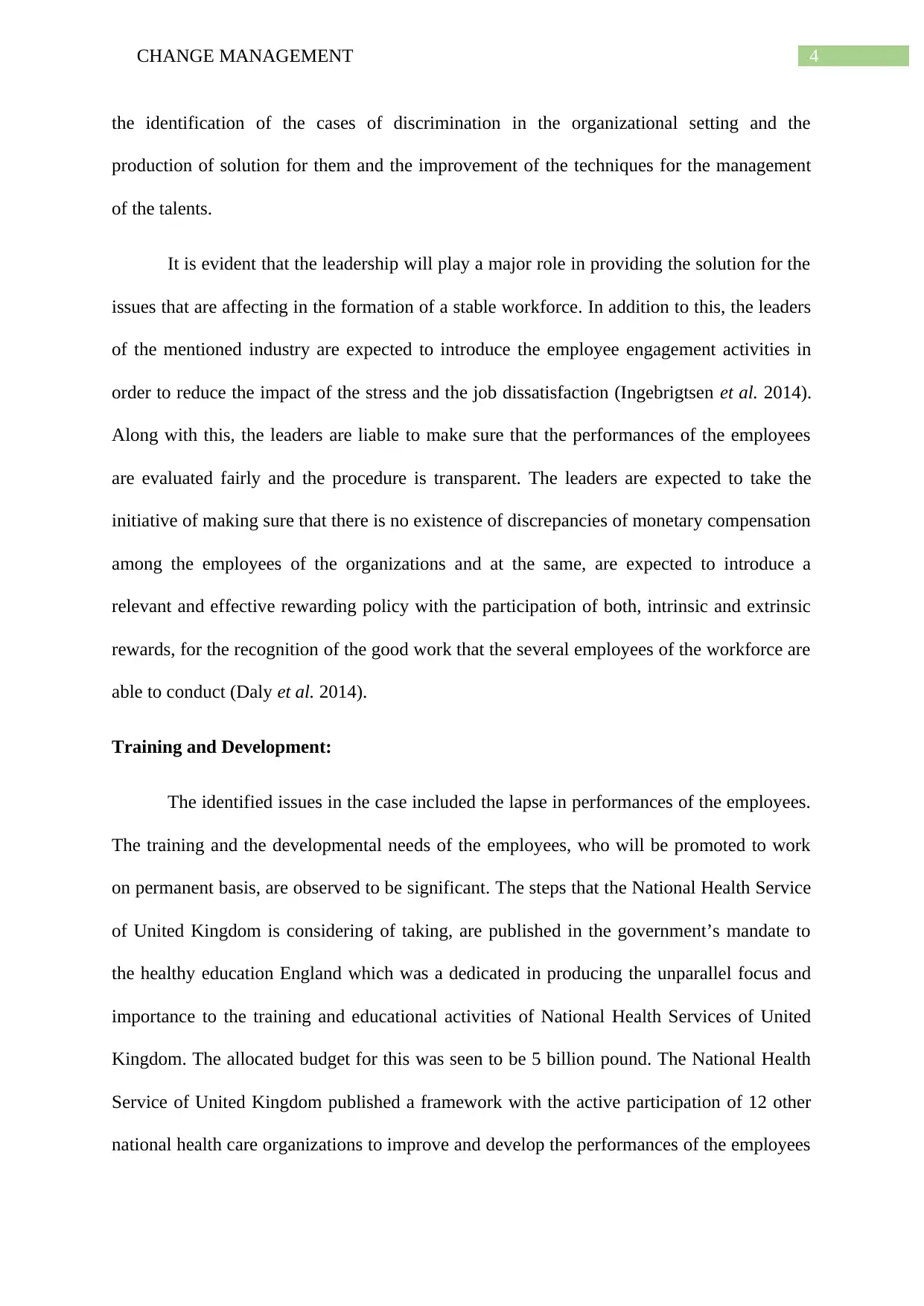
4CHANGE MANAGEMENT
the identification of the cases of discrimination in the organizational setting and the
production of solution for them and the improvement of the techniques for the management
of the talents.
It is evident that the leadership will play a major role in providing the solution for the
issues that are affecting in the formation of a stable workforce. In addition to this, the leaders
of the mentioned industry are expected to introduce the employee engagement activities in
order to reduce the impact of the stress and the job dissatisfaction (Ingebrigtsen et al. 2014).
Along with this, the leaders are liable to make sure that the performances of the employees
are evaluated fairly and the procedure is transparent. The leaders are expected to take the
initiative of making sure that there is no existence of discrepancies of monetary compensation
among the employees of the organizations and at the same, are expected to introduce a
relevant and effective rewarding policy with the participation of both, intrinsic and extrinsic
rewards, for the recognition of the good work that the several employees of the workforce are
able to conduct (Daly et al. 2014).
Training and Development:
The identified issues in the case included the lapse in performances of the employees.
The training and the developmental needs of the employees, who will be promoted to work
on permanent basis, are observed to be significant. The steps that the National Health Service
of United Kingdom is considering of taking, are published in the government’s mandate to
the healthy education England which was a dedicated in producing the unparallel focus and
importance to the training and educational activities of National Health Services of United
Kingdom. The allocated budget for this was seen to be 5 billion pound. The National Health
Service of United Kingdom published a framework with the active participation of 12 other
national health care organizations to improve and develop the performances of the employees
the identification of the cases of discrimination in the organizational setting and the
production of solution for them and the improvement of the techniques for the management
of the talents.
It is evident that the leadership will play a major role in providing the solution for the
issues that are affecting in the formation of a stable workforce. In addition to this, the leaders
of the mentioned industry are expected to introduce the employee engagement activities in
order to reduce the impact of the stress and the job dissatisfaction (Ingebrigtsen et al. 2014).
Along with this, the leaders are liable to make sure that the performances of the employees
are evaluated fairly and the procedure is transparent. The leaders are expected to take the
initiative of making sure that there is no existence of discrepancies of monetary compensation
among the employees of the organizations and at the same, are expected to introduce a
relevant and effective rewarding policy with the participation of both, intrinsic and extrinsic
rewards, for the recognition of the good work that the several employees of the workforce are
able to conduct (Daly et al. 2014).
Training and Development:
The identified issues in the case included the lapse in performances of the employees.
The training and the developmental needs of the employees, who will be promoted to work
on permanent basis, are observed to be significant. The steps that the National Health Service
of United Kingdom is considering of taking, are published in the government’s mandate to
the healthy education England which was a dedicated in producing the unparallel focus and
importance to the training and educational activities of National Health Services of United
Kingdom. The allocated budget for this was seen to be 5 billion pound. The National Health
Service of United Kingdom published a framework with the active participation of 12 other
national health care organizations to improve and develop the performances of the employees
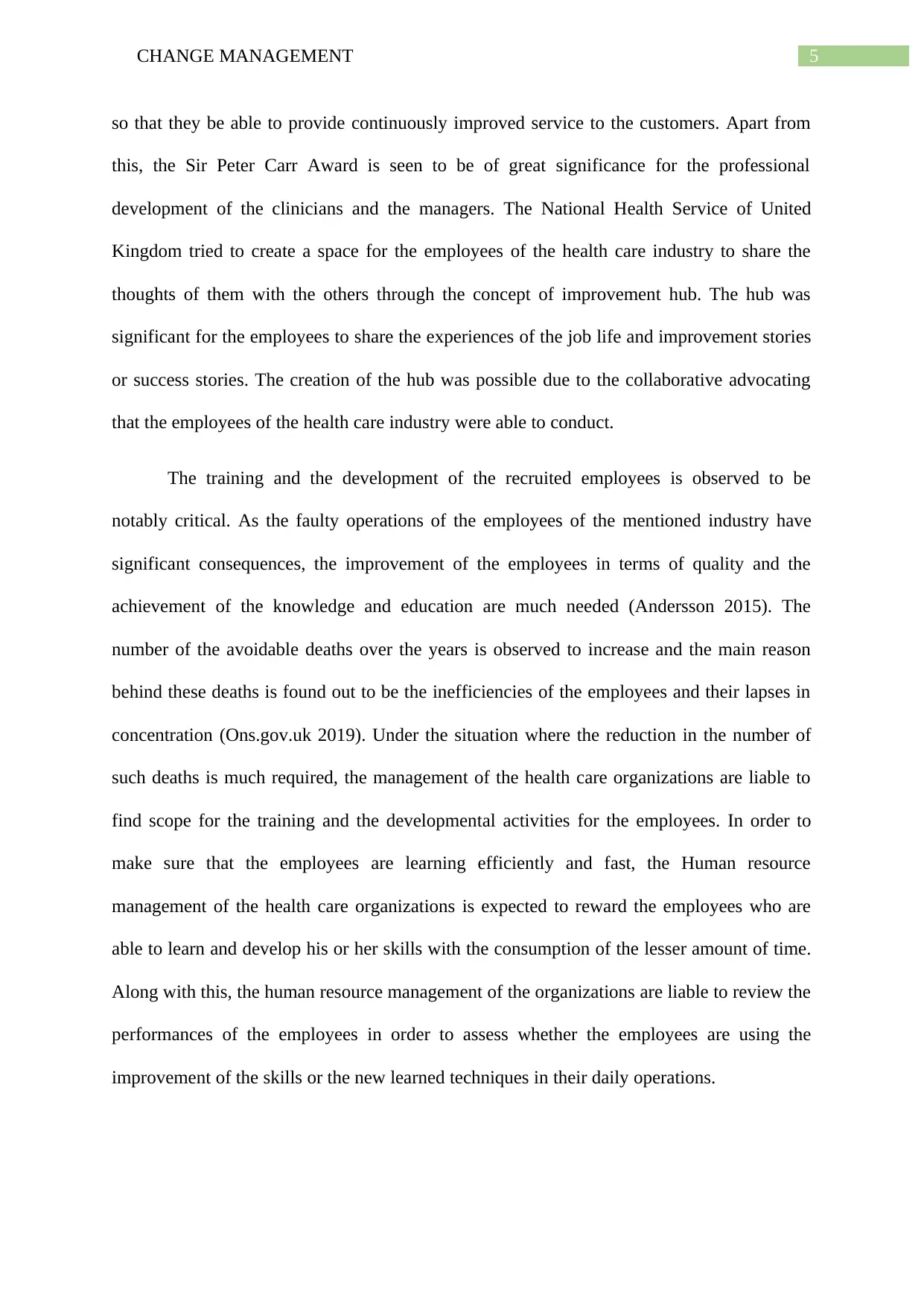
5CHANGE MANAGEMENT
so that they be able to provide continuously improved service to the customers. Apart from
this, the Sir Peter Carr Award is seen to be of great significance for the professional
development of the clinicians and the managers. The National Health Service of United
Kingdom tried to create a space for the employees of the health care industry to share the
thoughts of them with the others through the concept of improvement hub. The hub was
significant for the employees to share the experiences of the job life and improvement stories
or success stories. The creation of the hub was possible due to the collaborative advocating
that the employees of the health care industry were able to conduct.
The training and the development of the recruited employees is observed to be
notably critical. As the faulty operations of the employees of the mentioned industry have
significant consequences, the improvement of the employees in terms of quality and the
achievement of the knowledge and education are much needed (Andersson 2015). The
number of the avoidable deaths over the years is observed to increase and the main reason
behind these deaths is found out to be the inefficiencies of the employees and their lapses in
concentration (Ons.gov.uk 2019). Under the situation where the reduction in the number of
such deaths is much required, the management of the health care organizations are liable to
find scope for the training and the developmental activities for the employees. In order to
make sure that the employees are learning efficiently and fast, the Human resource
management of the health care organizations is expected to reward the employees who are
able to learn and develop his or her skills with the consumption of the lesser amount of time.
Along with this, the human resource management of the organizations are liable to review the
performances of the employees in order to assess whether the employees are using the
improvement of the skills or the new learned techniques in their daily operations.
so that they be able to provide continuously improved service to the customers. Apart from
this, the Sir Peter Carr Award is seen to be of great significance for the professional
development of the clinicians and the managers. The National Health Service of United
Kingdom tried to create a space for the employees of the health care industry to share the
thoughts of them with the others through the concept of improvement hub. The hub was
significant for the employees to share the experiences of the job life and improvement stories
or success stories. The creation of the hub was possible due to the collaborative advocating
that the employees of the health care industry were able to conduct.
The training and the development of the recruited employees is observed to be
notably critical. As the faulty operations of the employees of the mentioned industry have
significant consequences, the improvement of the employees in terms of quality and the
achievement of the knowledge and education are much needed (Andersson 2015). The
number of the avoidable deaths over the years is observed to increase and the main reason
behind these deaths is found out to be the inefficiencies of the employees and their lapses in
concentration (Ons.gov.uk 2019). Under the situation where the reduction in the number of
such deaths is much required, the management of the health care organizations are liable to
find scope for the training and the developmental activities for the employees. In order to
make sure that the employees are learning efficiently and fast, the Human resource
management of the health care organizations is expected to reward the employees who are
able to learn and develop his or her skills with the consumption of the lesser amount of time.
Along with this, the human resource management of the organizations are liable to review the
performances of the employees in order to assess whether the employees are using the
improvement of the skills or the new learned techniques in their daily operations.
⊘ This is a preview!⊘
Do you want full access?
Subscribe today to unlock all pages.

Trusted by 1+ million students worldwide
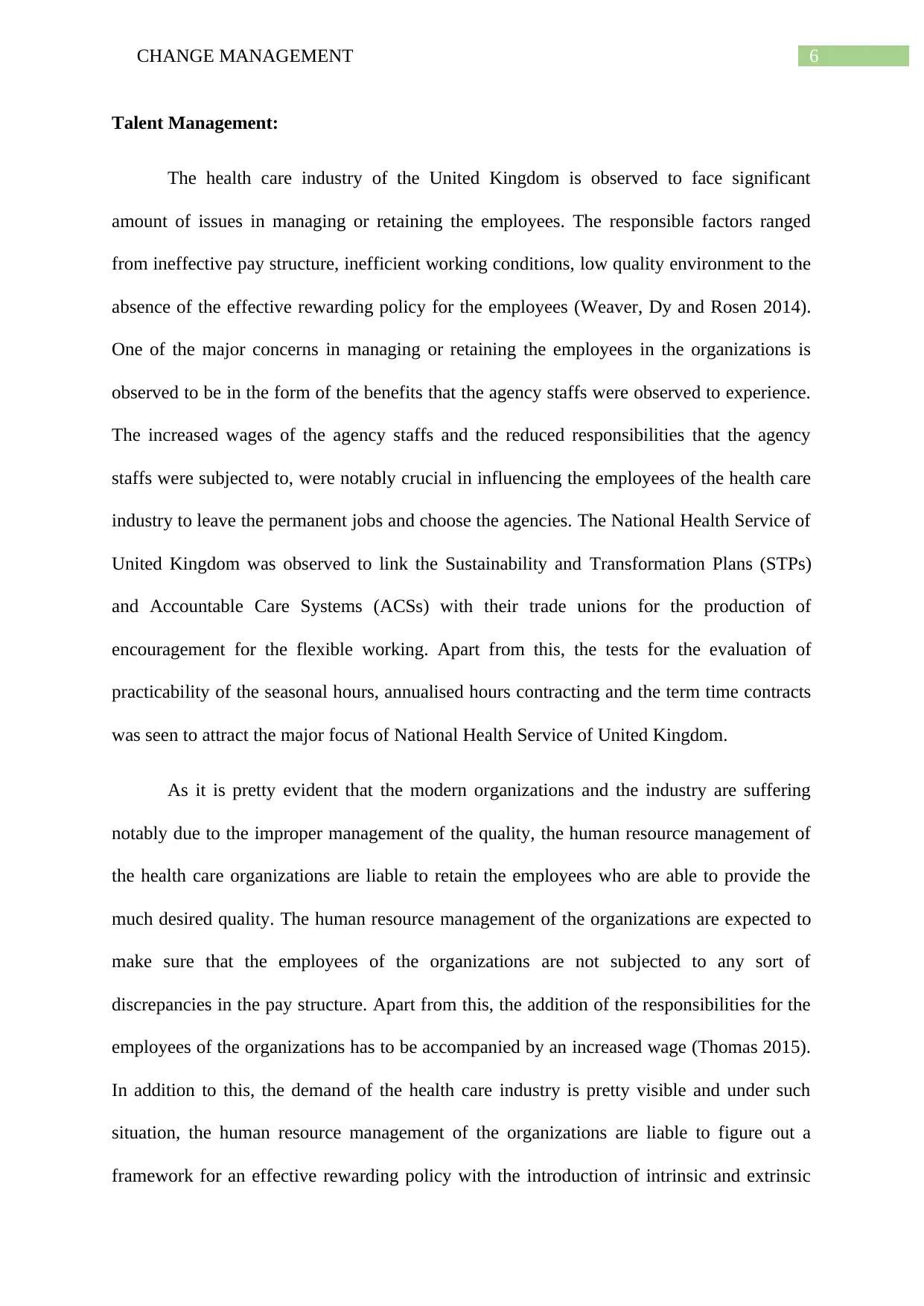
6CHANGE MANAGEMENT
Talent Management:
The health care industry of the United Kingdom is observed to face significant
amount of issues in managing or retaining the employees. The responsible factors ranged
from ineffective pay structure, inefficient working conditions, low quality environment to the
absence of the effective rewarding policy for the employees (Weaver, Dy and Rosen 2014).
One of the major concerns in managing or retaining the employees in the organizations is
observed to be in the form of the benefits that the agency staffs were observed to experience.
The increased wages of the agency staffs and the reduced responsibilities that the agency
staffs were subjected to, were notably crucial in influencing the employees of the health care
industry to leave the permanent jobs and choose the agencies. The National Health Service of
United Kingdom was observed to link the Sustainability and Transformation Plans (STPs)
and Accountable Care Systems (ACSs) with their trade unions for the production of
encouragement for the flexible working. Apart from this, the tests for the evaluation of
practicability of the seasonal hours, annualised hours contracting and the term time contracts
was seen to attract the major focus of National Health Service of United Kingdom.
As it is pretty evident that the modern organizations and the industry are suffering
notably due to the improper management of the quality, the human resource management of
the health care organizations are liable to retain the employees who are able to provide the
much desired quality. The human resource management of the organizations are expected to
make sure that the employees of the organizations are not subjected to any sort of
discrepancies in the pay structure. Apart from this, the addition of the responsibilities for the
employees of the organizations has to be accompanied by an increased wage (Thomas 2015).
In addition to this, the demand of the health care industry is pretty visible and under such
situation, the human resource management of the organizations are liable to figure out a
framework for an effective rewarding policy with the introduction of intrinsic and extrinsic
Talent Management:
The health care industry of the United Kingdom is observed to face significant
amount of issues in managing or retaining the employees. The responsible factors ranged
from ineffective pay structure, inefficient working conditions, low quality environment to the
absence of the effective rewarding policy for the employees (Weaver, Dy and Rosen 2014).
One of the major concerns in managing or retaining the employees in the organizations is
observed to be in the form of the benefits that the agency staffs were observed to experience.
The increased wages of the agency staffs and the reduced responsibilities that the agency
staffs were subjected to, were notably crucial in influencing the employees of the health care
industry to leave the permanent jobs and choose the agencies. The National Health Service of
United Kingdom was observed to link the Sustainability and Transformation Plans (STPs)
and Accountable Care Systems (ACSs) with their trade unions for the production of
encouragement for the flexible working. Apart from this, the tests for the evaluation of
practicability of the seasonal hours, annualised hours contracting and the term time contracts
was seen to attract the major focus of National Health Service of United Kingdom.
As it is pretty evident that the modern organizations and the industry are suffering
notably due to the improper management of the quality, the human resource management of
the health care organizations are liable to retain the employees who are able to provide the
much desired quality. The human resource management of the organizations are expected to
make sure that the employees of the organizations are not subjected to any sort of
discrepancies in the pay structure. Apart from this, the addition of the responsibilities for the
employees of the organizations has to be accompanied by an increased wage (Thomas 2015).
In addition to this, the demand of the health care industry is pretty visible and under such
situation, the human resource management of the organizations are liable to figure out a
framework for an effective rewarding policy with the introduction of intrinsic and extrinsic
Paraphrase This Document
Need a fresh take? Get an instant paraphrase of this document with our AI Paraphraser
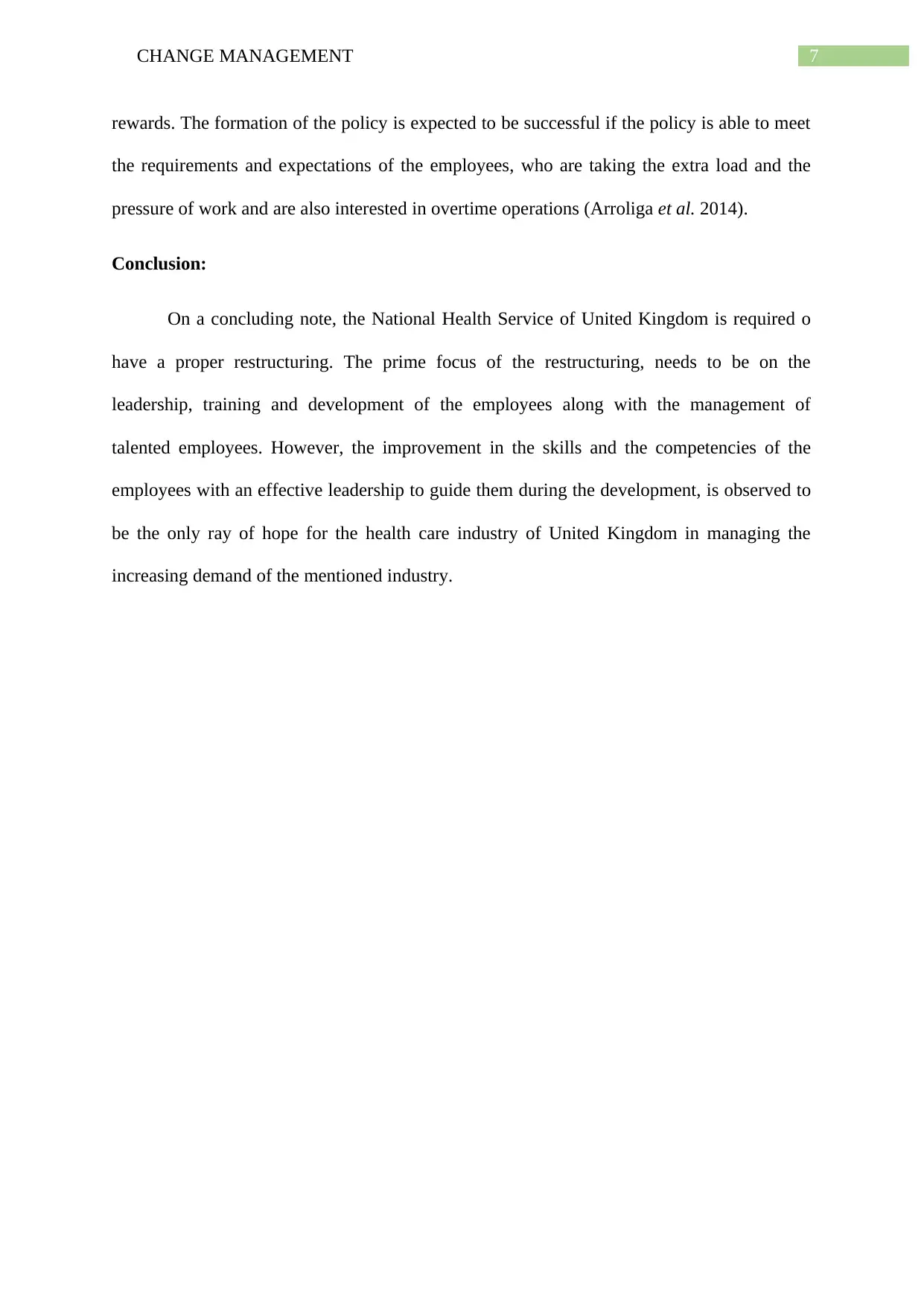
7CHANGE MANAGEMENT
rewards. The formation of the policy is expected to be successful if the policy is able to meet
the requirements and expectations of the employees, who are taking the extra load and the
pressure of work and are also interested in overtime operations (Arroliga et al. 2014).
Conclusion:
On a concluding note, the National Health Service of United Kingdom is required o
have a proper restructuring. The prime focus of the restructuring, needs to be on the
leadership, training and development of the employees along with the management of
talented employees. However, the improvement in the skills and the competencies of the
employees with an effective leadership to guide them during the development, is observed to
be the only ray of hope for the health care industry of United Kingdom in managing the
increasing demand of the mentioned industry.
rewards. The formation of the policy is expected to be successful if the policy is able to meet
the requirements and expectations of the employees, who are taking the extra load and the
pressure of work and are also interested in overtime operations (Arroliga et al. 2014).
Conclusion:
On a concluding note, the National Health Service of United Kingdom is required o
have a proper restructuring. The prime focus of the restructuring, needs to be on the
leadership, training and development of the employees along with the management of
talented employees. However, the improvement in the skills and the competencies of the
employees with an effective leadership to guide them during the development, is observed to
be the only ray of hope for the health care industry of United Kingdom in managing the
increasing demand of the mentioned industry.
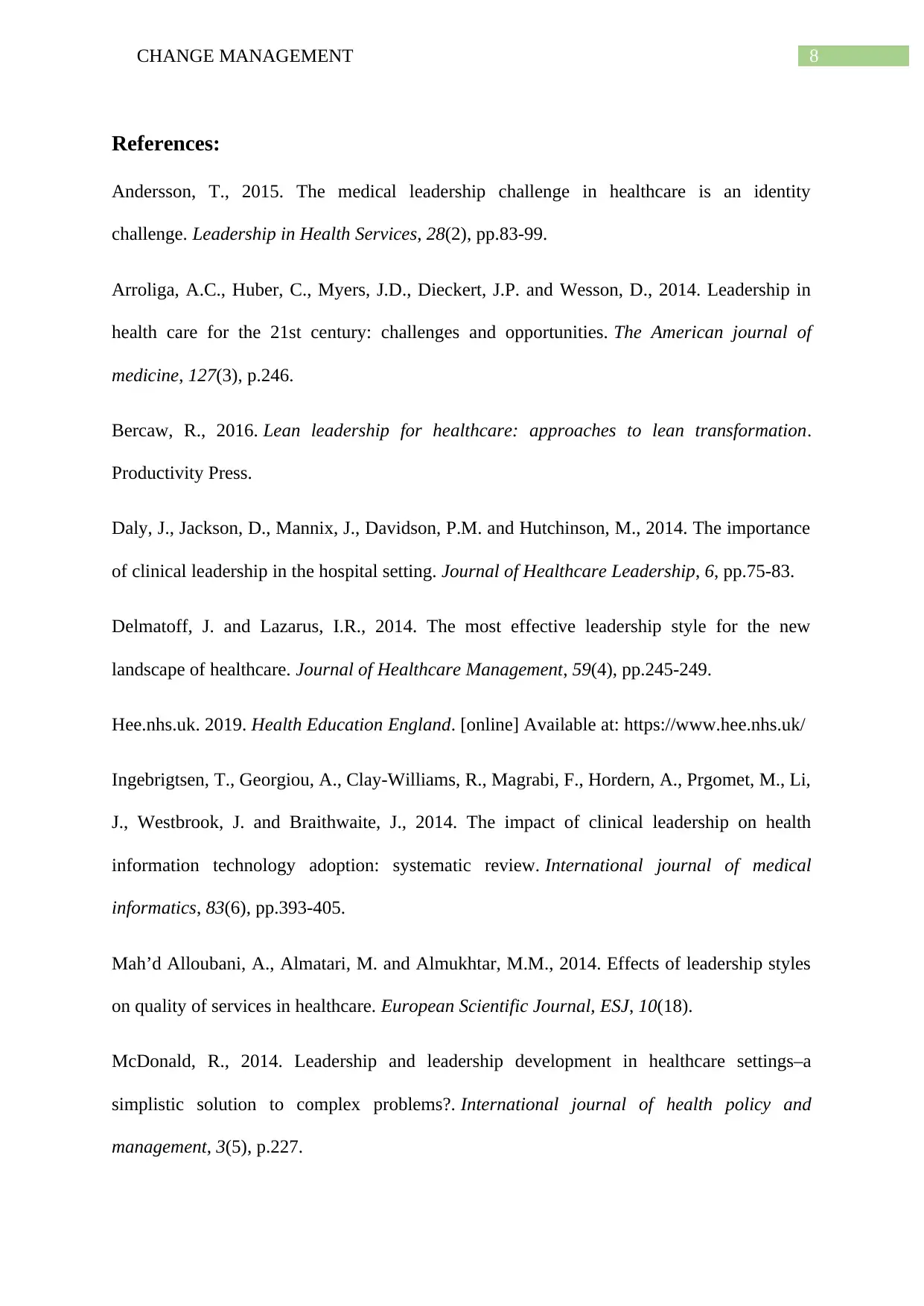
8CHANGE MANAGEMENT
References:
Andersson, T., 2015. The medical leadership challenge in healthcare is an identity
challenge. Leadership in Health Services, 28(2), pp.83-99.
Arroliga, A.C., Huber, C., Myers, J.D., Dieckert, J.P. and Wesson, D., 2014. Leadership in
health care for the 21st century: challenges and opportunities. The American journal of
medicine, 127(3), p.246.
Bercaw, R., 2016. Lean leadership for healthcare: approaches to lean transformation.
Productivity Press.
Daly, J., Jackson, D., Mannix, J., Davidson, P.M. and Hutchinson, M., 2014. The importance
of clinical leadership in the hospital setting. Journal of Healthcare Leadership, 6, pp.75-83.
Delmatoff, J. and Lazarus, I.R., 2014. The most effective leadership style for the new
landscape of healthcare. Journal of Healthcare Management, 59(4), pp.245-249.
Hee.nhs.uk. 2019. Health Education England. [online] Available at: https://www.hee.nhs.uk/
Ingebrigtsen, T., Georgiou, A., Clay-Williams, R., Magrabi, F., Hordern, A., Prgomet, M., Li,
J., Westbrook, J. and Braithwaite, J., 2014. The impact of clinical leadership on health
information technology adoption: systematic review. International journal of medical
informatics, 83(6), pp.393-405.
Mah’d Alloubani, A., Almatari, M. and Almukhtar, M.M., 2014. Effects of leadership styles
on quality of services in healthcare. European Scientific Journal, ESJ, 10(18).
McDonald, R., 2014. Leadership and leadership development in healthcare settings–a
simplistic solution to complex problems?. International journal of health policy and
management, 3(5), p.227.
References:
Andersson, T., 2015. The medical leadership challenge in healthcare is an identity
challenge. Leadership in Health Services, 28(2), pp.83-99.
Arroliga, A.C., Huber, C., Myers, J.D., Dieckert, J.P. and Wesson, D., 2014. Leadership in
health care for the 21st century: challenges and opportunities. The American journal of
medicine, 127(3), p.246.
Bercaw, R., 2016. Lean leadership for healthcare: approaches to lean transformation.
Productivity Press.
Daly, J., Jackson, D., Mannix, J., Davidson, P.M. and Hutchinson, M., 2014. The importance
of clinical leadership in the hospital setting. Journal of Healthcare Leadership, 6, pp.75-83.
Delmatoff, J. and Lazarus, I.R., 2014. The most effective leadership style for the new
landscape of healthcare. Journal of Healthcare Management, 59(4), pp.245-249.
Hee.nhs.uk. 2019. Health Education England. [online] Available at: https://www.hee.nhs.uk/
Ingebrigtsen, T., Georgiou, A., Clay-Williams, R., Magrabi, F., Hordern, A., Prgomet, M., Li,
J., Westbrook, J. and Braithwaite, J., 2014. The impact of clinical leadership on health
information technology adoption: systematic review. International journal of medical
informatics, 83(6), pp.393-405.
Mah’d Alloubani, A., Almatari, M. and Almukhtar, M.M., 2014. Effects of leadership styles
on quality of services in healthcare. European Scientific Journal, ESJ, 10(18).
McDonald, R., 2014. Leadership and leadership development in healthcare settings–a
simplistic solution to complex problems?. International journal of health policy and
management, 3(5), p.227.
⊘ This is a preview!⊘
Do you want full access?
Subscribe today to unlock all pages.

Trusted by 1+ million students worldwide
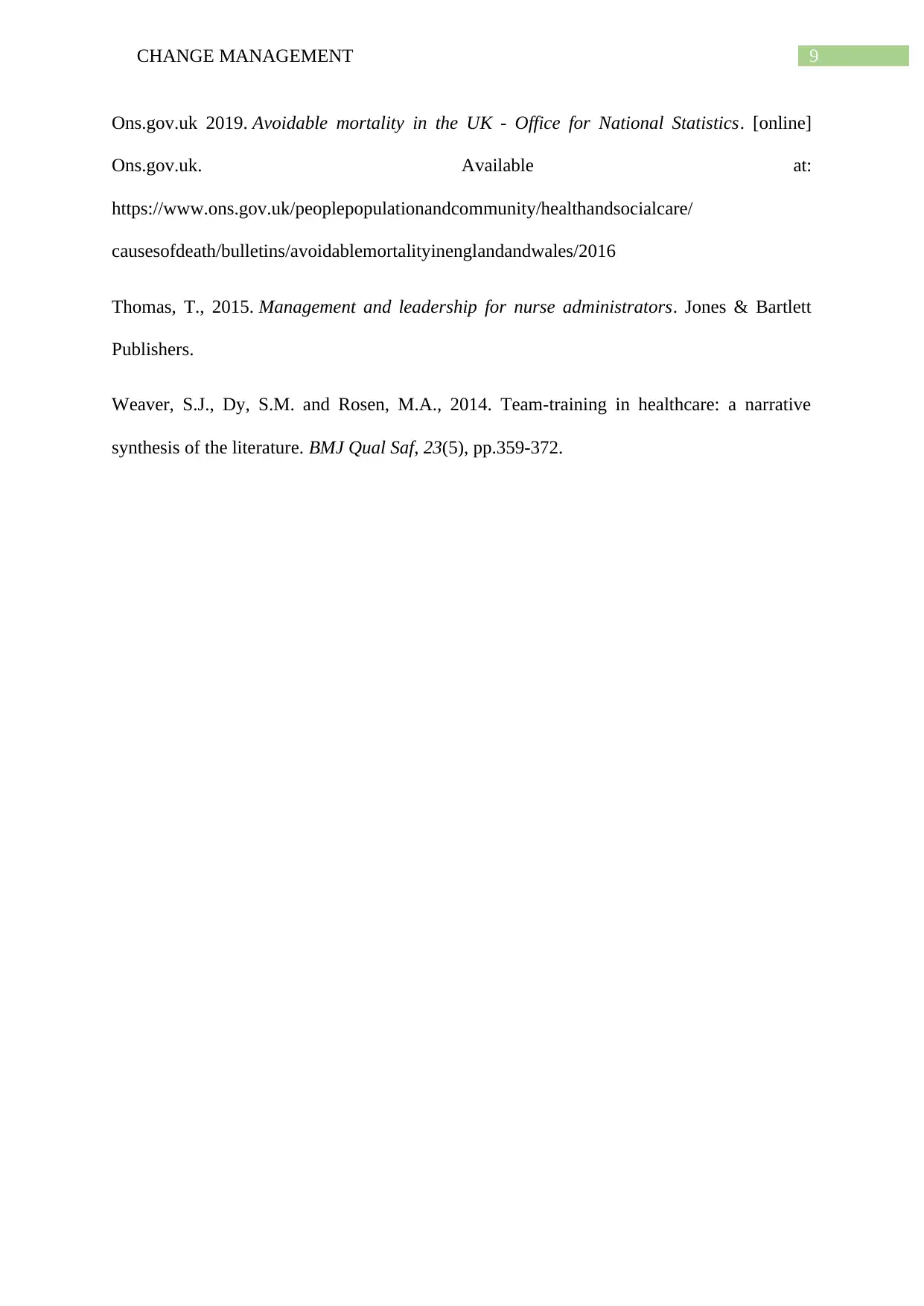
9CHANGE MANAGEMENT
Ons.gov.uk 2019. Avoidable mortality in the UK - Office for National Statistics. [online]
Ons.gov.uk. Available at:
https://www.ons.gov.uk/peoplepopulationandcommunity/healthandsocialcare/
causesofdeath/bulletins/avoidablemortalityinenglandandwales/2016
Thomas, T., 2015. Management and leadership for nurse administrators. Jones & Bartlett
Publishers.
Weaver, S.J., Dy, S.M. and Rosen, M.A., 2014. Team-training in healthcare: a narrative
synthesis of the literature. BMJ Qual Saf, 23(5), pp.359-372.
Ons.gov.uk 2019. Avoidable mortality in the UK - Office for National Statistics. [online]
Ons.gov.uk. Available at:
https://www.ons.gov.uk/peoplepopulationandcommunity/healthandsocialcare/
causesofdeath/bulletins/avoidablemortalityinenglandandwales/2016
Thomas, T., 2015. Management and leadership for nurse administrators. Jones & Bartlett
Publishers.
Weaver, S.J., Dy, S.M. and Rosen, M.A., 2014. Team-training in healthcare: a narrative
synthesis of the literature. BMJ Qual Saf, 23(5), pp.359-372.
Paraphrase This Document
Need a fresh take? Get an instant paraphrase of this document with our AI Paraphraser
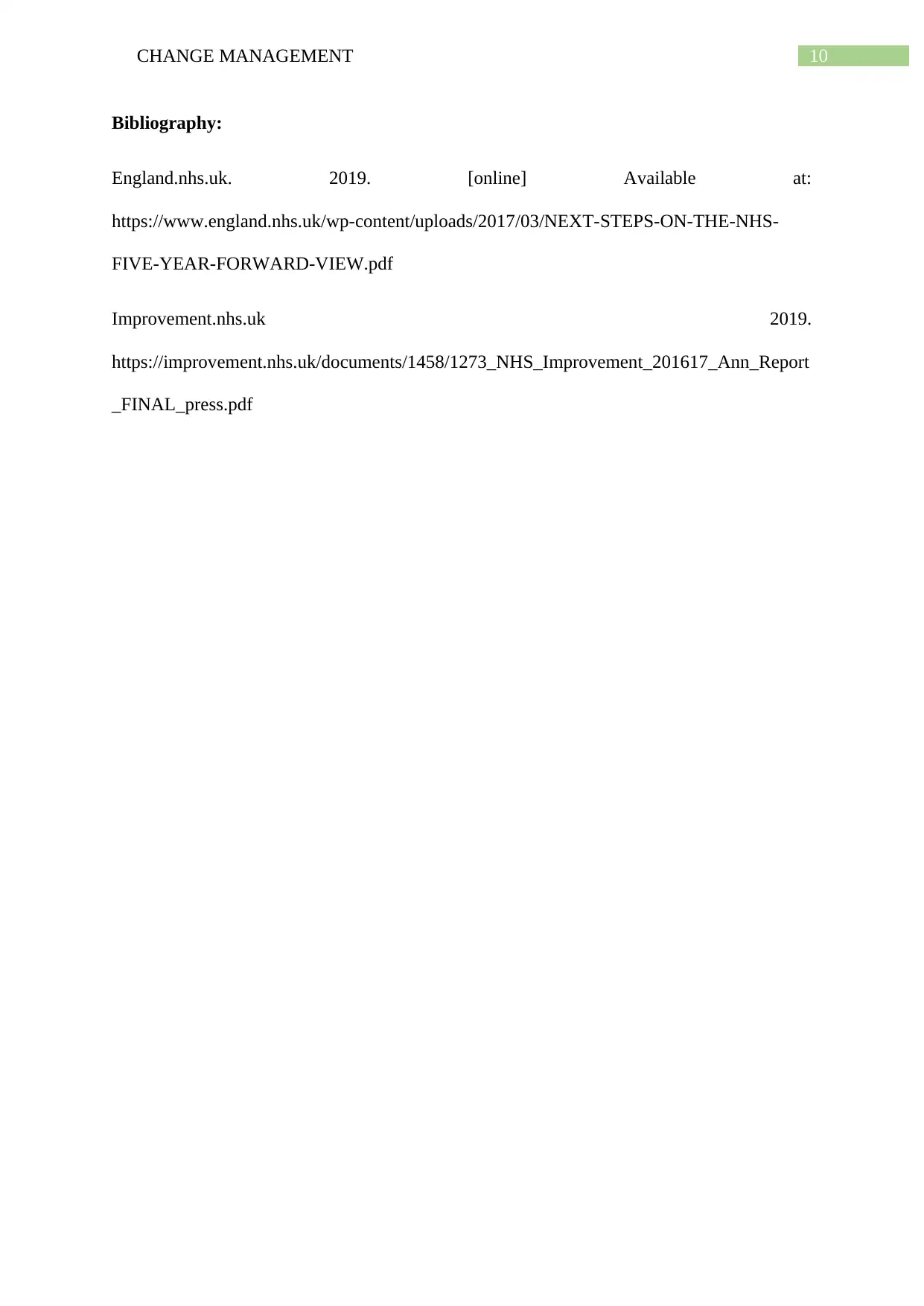
10CHANGE MANAGEMENT
Bibliography:
England.nhs.uk. 2019. [online] Available at:
https://www.england.nhs.uk/wp-content/uploads/2017/03/NEXT-STEPS-ON-THE-NHS-
FIVE-YEAR-FORWARD-VIEW.pdf
Improvement.nhs.uk 2019.
https://improvement.nhs.uk/documents/1458/1273_NHS_Improvement_201617_Ann_Report
_FINAL_press.pdf
Bibliography:
England.nhs.uk. 2019. [online] Available at:
https://www.england.nhs.uk/wp-content/uploads/2017/03/NEXT-STEPS-ON-THE-NHS-
FIVE-YEAR-FORWARD-VIEW.pdf
Improvement.nhs.uk 2019.
https://improvement.nhs.uk/documents/1458/1273_NHS_Improvement_201617_Ann_Report
_FINAL_press.pdf
1 out of 11
Related Documents
Your All-in-One AI-Powered Toolkit for Academic Success.
+13062052269
info@desklib.com
Available 24*7 on WhatsApp / Email
![[object Object]](/_next/static/media/star-bottom.7253800d.svg)
Unlock your academic potential
Copyright © 2020–2025 A2Z Services. All Rights Reserved. Developed and managed by ZUCOL.




